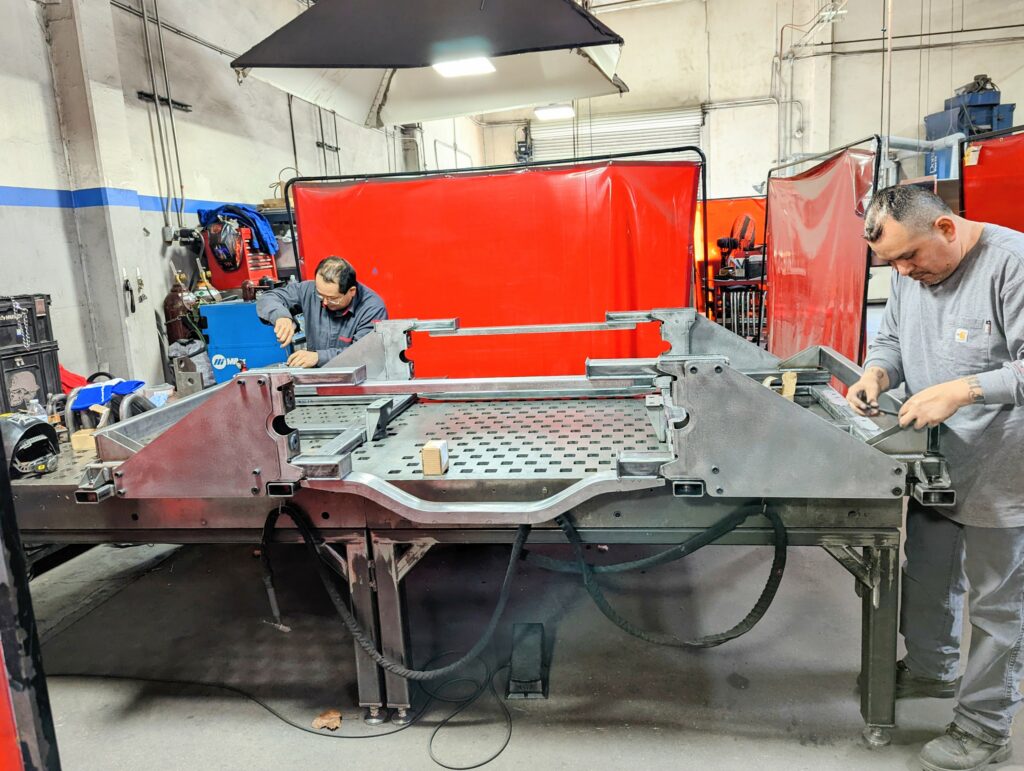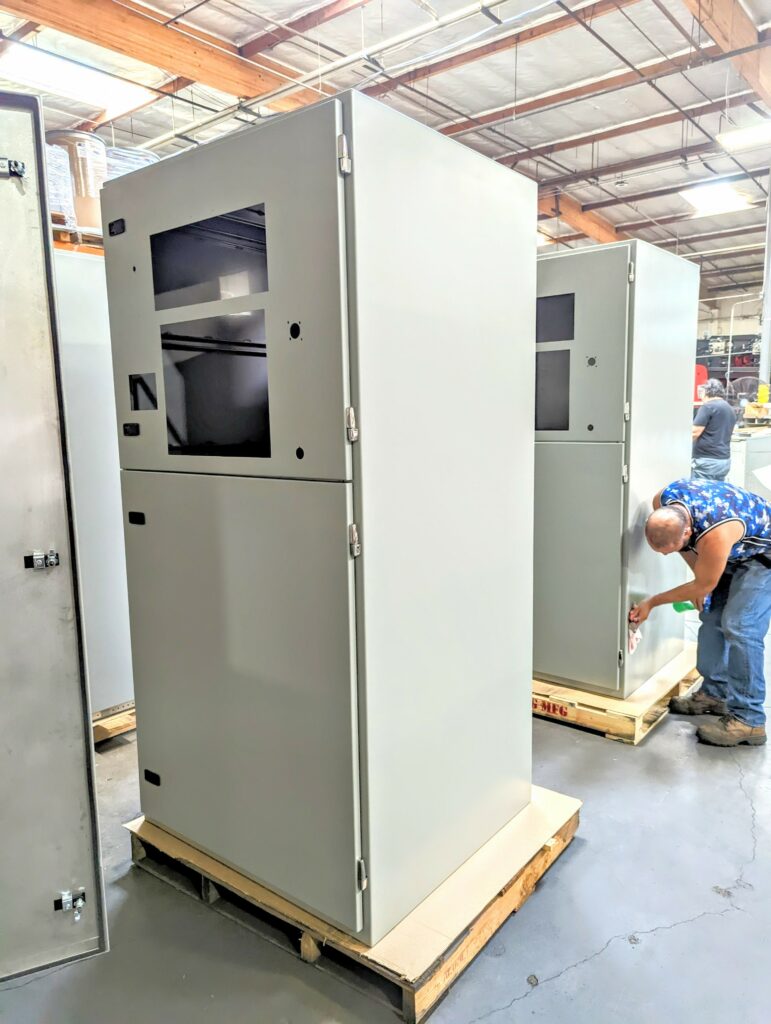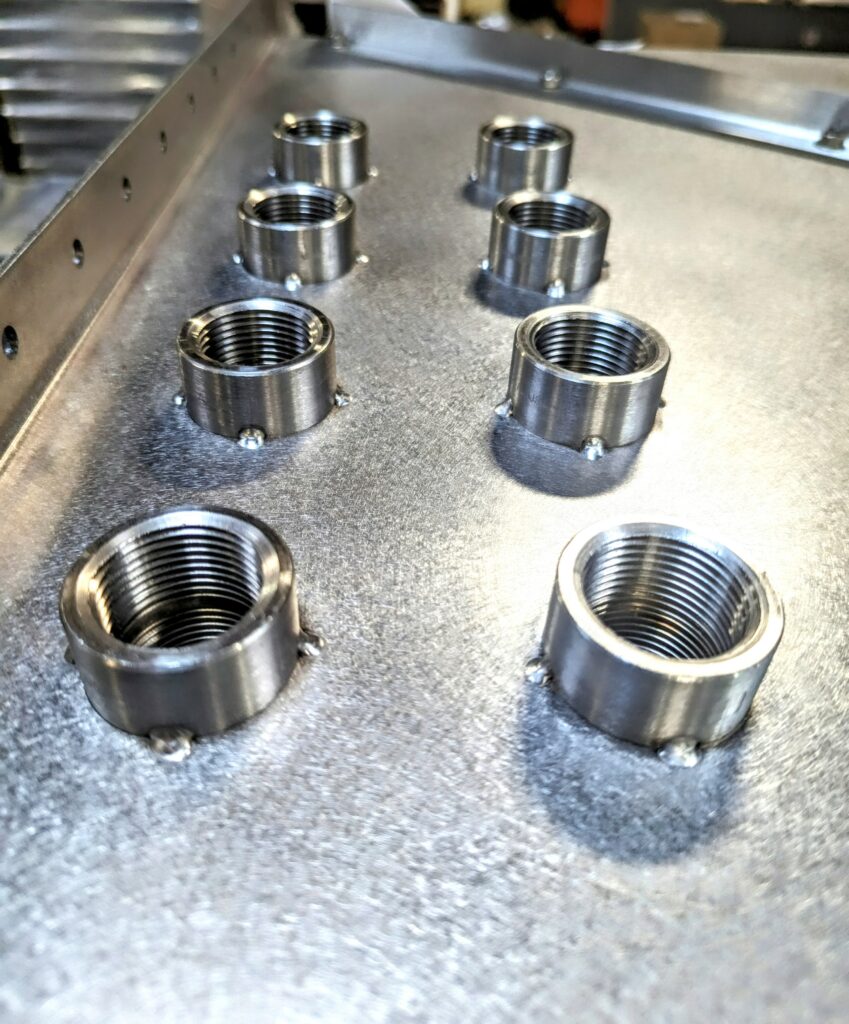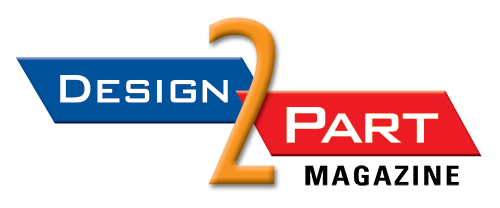
Continental Industries team members tackle a metal fabrication project. (Photo courtesy Continental Industries)
By leveraging a variety of advanced technologies, the precision sheet metal fabricator is elevating its efficiency and expanding its ability to take on new jobs.
By Mark Shortt
As North American demand for sheet metal fabricated parts has surged in recent years, Continental Industries (CI) has grown with it, introducing new technologies into its operations and adding 6,000 square feet of warehouse space across the street from its 25,000-square-foot manufacturing facility in Anaheim, California. Today, the company’s advanced manufacturing capabilities include fiber and CO2 laser cutting with multi-shelf towers, two turret punch presses, and automated sheet loading/unloading systems.
“Our facilities are equipped with laser inspection technology and full SPC reporting, along with six press brakes featuring eight-axis back gauges,” said Continental Industries Director of Sales Mike Moss, in an emailed response to Design-2-Part. “Additionally, we provide MIG, TIG, spot, and laser welding, performed by certified welders. These capabilities enable us to cost-effectively produce high-quality parts, enhance throughput, and maintain operational flexibility to meet our customers’ needs.”
Continental Industries is a precision sheet metal fabricator that offers services ranging from laser cutting and turret punching, to press brake forming, welding, CNC machining, and hardware insertion. The company produces component parts and full mechanical assemblies for defense and homeland security contractors, as well as companies in the aircraft/aerospace, commercial, and medical sectors.
Parts produced by the company range from electronic chassis, rackmount enclosures, “Hoffman” style enclosures, and box builds, to medical device enclosures and electronic test and measurement equipment. Continental has also fabricated RF systems, data storage racks, flight simulation, and ground support equipment, Moss said.
Efficiency in its manufacturing operations is a prime focus at Continental Industries, and one of the keys to its recent growth. Moss credits the company’s advanced engineering software and its integration of automation into shop floor operations for helping to elevate its efficiency. The software enables any potential manufacturing problems to be corrected and addressed at the design stage prior to production, which saves time and money.
“This allows the programming department to create the program, the bend sequences, and select tooling, streamlining the process for the machine operator,” he explained.
The company’s turret punch presses are equipped with automated sheet loading/unloading capabilities, and its inspection process is also automated.
“Our laser inspection machine is capable of reverse engineering 2D flat parts, performing 1st article inspections, in process inspection, and can generate a variety of SPC reports that can be emailed directly to our customers,” Moss told D2P. “The inspection machine has reduced our first article inspection time, while at the same time increasing the accuracy of the inspection by eliminating human error. What might have taken hours in the past will now take minutes to complete. This level of automation allows our personnel to run our customer’s parts in the most efficient manner possible.”
Moss said that Continental Industries’ pricing is competitive, its facilities are very well equipped, but its service sets it apart. Communication is a critical component in the company’s relationships with its customers.
“We acknowledge the receipt of RFQs, we send order acknowledgements with due dates, we respond quickly to inquiries and open order reports. This responsiveness gives our customers a feeling that they relate to us and, as a result gives them a feeling of comfort. This is not something we can put on a quote or on our facilities list, but it is one of our biggest strengths and a large part of the success we have with our customers.”
Design-2-Part caught up with Continental Industries’ Mike Moss recently to discuss Continental’s sheet metal fabrication capabilities, current markets for it services, and how its new technologies are providing opportunities for further growth. Following is a transcript of our phone interview, edited for length and clarity.
Design-2-Part: If you were talking to a potential customer, what should they know about Continental’s sheet metal fabrication services, right off the bat?
Mike Moss: That we offer precision sheet metal fabrication services. What we have is a facility that lends itself to high production. We have load/unload capabilities on our punches, lights out fabrication capacity, automation on our press brakes, and automation on our lasers. We have fiber laser, state of the art equipment—full tower, with multiple pallet changers for lights out operation.
D2P: It sounds like you’ve geared yourself to provide 24/7 service.
MM: Yes, we absolutely can. And in the event where it’s not 24/7 service, the automation lends itself to efficiency, where we don’t have a person loading, unloading these sheets as the jobs change; it’s all set in the program. The material is loaded onto the pallet racks and the machine automatically runs and sorts parts according to the schedule.
So, we set the program and the nest and the load in the morning, and it runs efficiently through the day. All we have to do is maintain material in the machine, and it will continue to pull material and run parts as it’s programmed.

Metal enclosures, a specialty of Continental Industries, near completion at the company’s facility. (Photo courtesy Continental Industries)
D2P: There are many good reasons for implementing automation. What was the biggest factor in your company’s decision to go that route?
MM: It would be efficiency. One way to run a machine is to have an operator that would pick up a shop traveler, look at what he’s going to run, and have a forklift driver bring over a pallet of material and load these things into the machine, run that, and then repeat that every time that job finishes. That’s the manual way. But now, we load the nest in the morning with all of the jobs for the day. The operator runs the machine from the control, and as long as the pallets are full of material, it will run more efficiently and seamlessly.
D2P: Why do customers come to your company for help, and what are they looking for?
MM: A lot of times they say, ‘We’ve been working with the same guy for a long period of time, and we’ve outgrown him.’ The demand is increasing to the point where they’ve overloaded their current supplier. [Their supplier is] a smaller shop, they were great when they got started, but now they need to have someone who can keep up with the demand. That’s one scenario.
Another scenario is where customers come to us with quality issues. They say a lot of the parts that they’re getting in from their current vendor have to be reworked or sent back. These things happen in every shop, but parts shouldn’t leave a facility unless they meet the quality standards that the customer put out. So they’re looking for an upgrade in the type of business that they’re working with—someone who checks and has first article reports, someone who can provide a quality part the first time.
There are others who hire volume shops and they’re looking to add vendors to their list, where they run thousands of parts and hundreds of different part numbers. They say, ‘We have five shops that we have loaded, and we have enough to keep you guys busy. We need to get another quality shop online to help us keep up with production.’
D2P: Some of the markets that your company serves include aerospace, defense, data, communications, medical, automotive, and lighting. Are there any others that I’m missing?
MM: We’re a job shop, so we can take in just about anything. We do work in electrical panel markets, we’ve done work with cities and municipalities, but those are the core of our business. I think those industries tend to repeat.
But there’s a lot of growth in that data center market. With all of the internet companies, like Microsoft and Google and Tik Tok and all the social media guys, when they started growing, they needed capacity for all of their users. Now, with the introduction of artificial intelligence, all that AI material out there is consuming a lot of space. There’s a big boom in the market to keep up with the AI demand.
Lighting is another market, and the medical industry is always evolving. So those are our core markets.

Couplings welded onto an assembly. (Photo courtesy Continental Industries)
D2P: Are you also seeing strong demand from the aerospace and defense markets?
MM: Absolutely. In fact, we’ve got a meeting tomorrow with one of the defense contractors who wants to bring another vendor on board. There are a lot of online platforms that are gearing towards a central space for fabricators like ourselves, to list our company and put our expertise in there. And the defense contractors themselves are targeting our capabilities, whether it’s machining or another phase in manufacturing, and they’re sending us quotes out for bid for various projects. Yes, it’s a very strong market right now.
D2P: What are some examples of the types of parts that you manufacture? You mentioned enclosures.
MM: Yes. We do a lot in machinery as well—a lot of the machinery companies out there who build industrial machines. We do a lot of control boxes, we do frames. We also do a lot of work now on the homeland security side, with personal body scanning for the airports and the institutions—the jails, the prisons, where they scan bodies. There’s lots of technology [developers] in that area that we’re partnering with.
D2P: I understand you’ve added some new equipment to your facility recently. What led to those acquisitions, and how have they been working out?
MM: They’ve worked out very well. We used to have five manual turret punch presses on the floor. We’ve sold off most of those and we brought in just two to replace them. They’re electro-servo machines, which are faster, but they have the sheet loaders and the capacity load/unload system. So the two machines that we have now are outperforming the five that we had on the floor. Bringing in the turret punches with automation was a great help.
We’ve also introduced laser welding into our portfolio. We’ve had the standard spot welding capacity, MIG and TIG welding, standard resistance welding, but now we’ve added laser welding, which is opening up a new market. It’s able to run cooler, more consistently, give a thinner bead, with less material distortion. There’s a whole market for that, and customers are attracted to it for their own reasons. Then they say, ‘Hey, I see you have laser welding capabilities. Can you guys do this?’ So we evaluate that, and it’s something that’s been successful in bringing in new business.
As we speak, we’re having a new fiber laser machine installed. It’s a 6,000-Watt fiber powered laser; it’s not a CO2 [laser]. This is also a full cell with automation and end pallet material stacker that goes all the way to the ceiling in the shop. So it’s absolutely full-on automation. It’s going to take a couple of weeks for them to get it fully integrated into the floor, but it’s being installed as we speak.
We’re still in the same building—25,000 square feet of manufacturing space, but we just acquired an additional 6,000 square feet of warehouse space, so we can have capacity for raw material and finished parts.
D2P: Is the laser that you mentioned a laser cutter?
MM: Yes, it’s a fiber laser cutting machine. We used to have a standalone 4,000 Watt CO2 laser cutter, and this is a 6,000 Watt fiber laser. It’s much faster, cleaner, and it has fewer breakdown problems than the older laser had. It has fewer parts, which is better, so it’s a lot faster and a lot more powerful. But it is a laser cutting machine.
D2P: The older one—was that the Amada LC3015?
MM: That’s right. 4,000 Watts, CO2. That’s the old one.
D2P: It sounds like even that one had some pretty good advantages in speed and the ability to monitor the cut.
MM: Yes, absolutely.
D2P: In summary, how would you describe some of the advantages of your newest laser?
MM: The newer laser has 2,000 more Watts of cutting capacity, which allows us to cut thicker material, and also do some things that we couldn’t before. We can actually pierce smaller holes in thicker material. It takes a lot of power to do that. You normally want it to have like a one-to-one ratio; you wouldn’t want to go too much thinner than the material thickness on the hole because the machine didn’t have the power to do that.
This machine has the power to do a lot of things that the other one didn’t. It’s faster, it can cut thicker material. It has less consumables as far as gases, et cetera. It’s fiber powered, so there’s going to be an increase in efficiency. This is the one that we’re going to be able to load all of the parts on there. It’s going to be an all-around faster machine—not just in its ability as the machine itself, but combined with the automation, we’re going to be able to run so much more efficiently.
D2P: Could you summarize the advantages that your press brake technology provides?
MM: Sure. All of them are touchscreen controlled, PC-based, and they’re all programmed offline. They have multi-axis back gauges. Standard machines are 3- or 4-axis back gauges; we have ours equipped with 8-axis back gauges that are able to crown dynamically. To do corrections in the bend process, the back gauges move within 8 axes of each other so that they can take on various contours and configurations of complex parts.
A standard operator would have to fixture something in front of the machine in order to set up these complex bends. The machine, once it understands through the program what you’re trying to do, has the ability to move the back gauges independently and set that up. So that’s huge.
And we also have equipped one of our press brakes with a sheet follower system, which is for large, heavy parts. That actually goes in front of the press brake and assists in moving the heavy parts up. During the bending process, where we would have to have two or three or four guys hold a large piece of metal in front of the machine, the sheet followers are able to do that themselves with a single operator. So that’s increased efficiency. We can keep one guy on the machine, working on the parts, with the sheet follower system.
MM: The company’s value-added services include new product design, design for manufacturing, and value engineering. Could you talk a little bit about why those value-added services, particularly the design and engineering support, are so important?
MM: We don’t do much in the engineering, in that our customers typically engineer their own parts, but they’ll come to us when they need help in design for manufacturing, or new product design. Or they’ll come to us and say, ‘These are concepts. We’ve done this, we’ve gotten this far, but our problem is [where they can’t take it to the next level]. How do they get this to be able to be fabricated in a way that’s not tremendously expensive? They run into a wall where the software can design the part, but it’s not necessarily feasible to manufacture it in that way.
We can sit down with them and get down to where it’s manufacturable, or more cost efficient to manufacture it through our design help, where we say, ‘Okay, now we can manufacture the part if we make these changes.’ That’s a help to a lot of people.
We have some people who are in the design phase or prototype phase of new products at smaller companies, or individuals who are bringing products to market, where they need that help. They don’t have an infrastructure, a company where they have designers and programmers that can do that. So they’ll come to us with a small prototype and some simple sketches that they’ve done on the computer, and we can help them get these into 3D models and manufacturing blueprints.
Thanks to the design service, now they’ll have the ability to run parts. So, it’s a good source of getting customers through the door and maintaining a good relationship from the ground up.
D2P: Do you have a good number of customers who come to you with new products that you help them get started?
MM: Yes, we do, and we’ll get stuff that comes through the email, through the website, on our inquiry pages from time to time. But trade shows seem to be where we attract most of that business. We’ll have a tabletop there that has similar parts—parts that show well on a desktop table. And they’ll come to us and they’ll point at it and they’ll say, ‘I have an enclosure that looks like this.’ Or they’ll show us a picture on a cellphone, or they’ll show us something and say, ‘Can you guys help me design this?’
Then we’ll get things started after the show. They can come out and we’ll have a meeting and we’ll get going. We get most of that business from the tradeshow, but we occasionally get it through our website.
D2P: What actions does your company take to ensure the highest quality of the parts that you produce? In reading your website, it looked like it was a combination of the equipment that you have, the process and procedures you follow, and the fact that you have experienced people.
MM: Yes, we’ve definitely got experienced people. We have quality manuals and standards that we have to adhere to. We’re not an ISO certified company, but we’re ISO compliant, so we have all of our processes outlined and we have to do what we have outlined.
A lot of companies, when they want to come in and evaluate us in the beginning, they want to see what we have, as far as our inspection equipment. We also provide them with our quality manual, which provides our processes.
Our laser inspection machine has been a great help in that department because it’s compatible with many of the disciplines—Lean Manufacturing, Six Sigma, ISO, as far as inspection. It automates a process that was normally done by a human, which eliminates the human error. And that is really good [compared to] a guy with calipers and measuring devices who checks these parts manually. This is done via a laser scan, and the machine collects that data and compares it against the CAD file that the customer provided. So we can see, in real time, what the status is of the part that we fabricated, versus the electronic data that the customer provided. That can be done in minutes, rather than hours of work, where a person would have to take each measurement.
D2P: Does your automated laser inspection machine also perform in process inspection?
MM: It does in process inspection, sure. If a customer is running a thousand parts and he wanted to check every hundredth part, we can do that. It also has the ability to generate SPC reporting in different formats that can be emailed directly from the machine itself to the customer.
D2P: What else should people know about Continental Industries that I haven’t asked about?
MM: We’ve been in a growth mode over the last year or so. The decision to bring in all of this new equipment and expand our floor space is the result of our growth, where we’ve really started expanding and bringing in larger customers, bringing in a lot more business. We needed the floor space, we needed the efficiency, We’ve been in a tremendous growth mode, and we’re continuing to do so. We see 2025 as being even bigger than last year.
D2P: Approximately how many people do you employ right now?
MM: We’re holding at about 50 employees. Those are direct employees, and we also have some temporary staff that we bring in.
